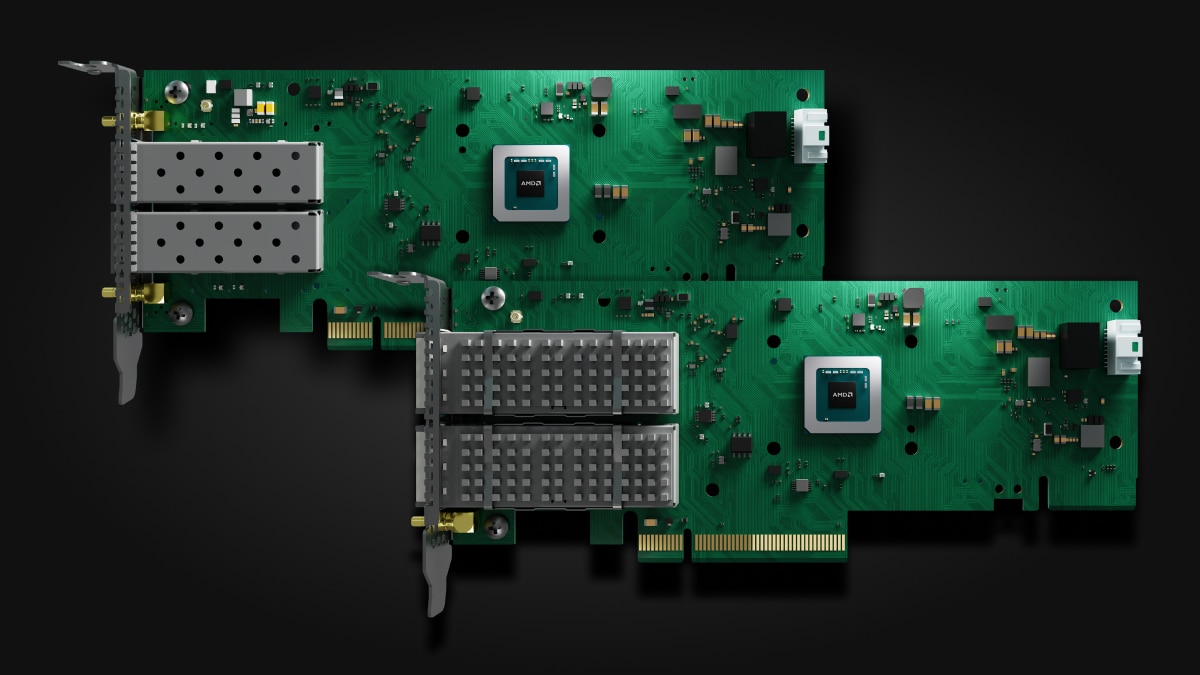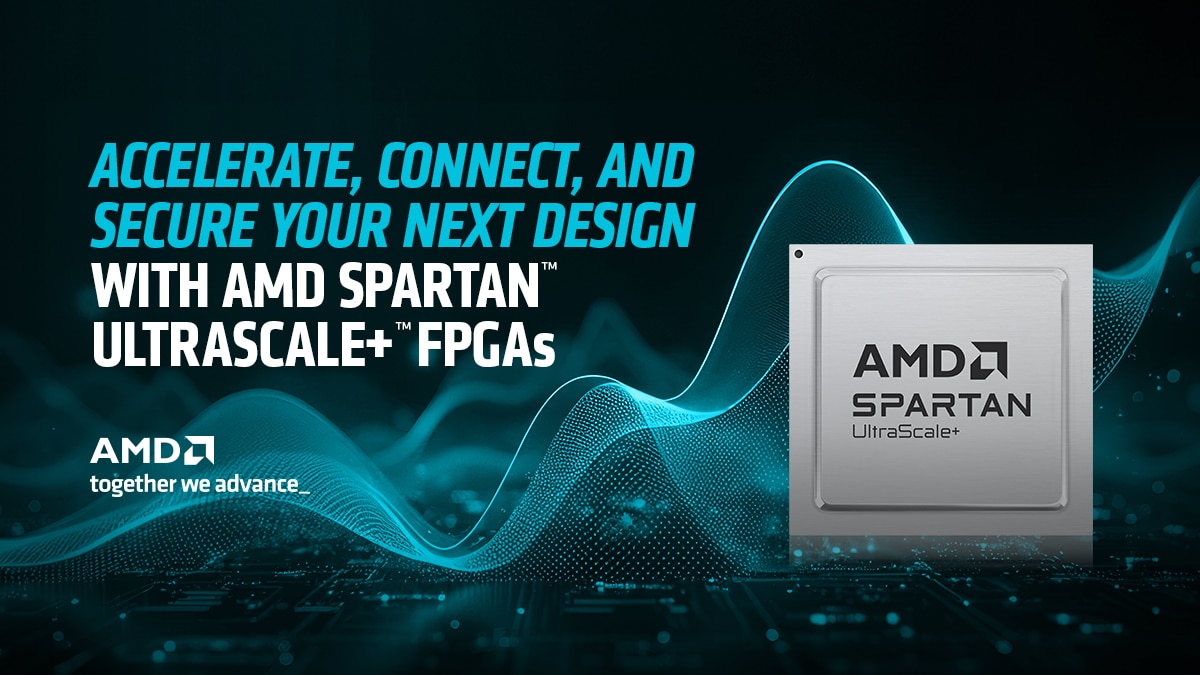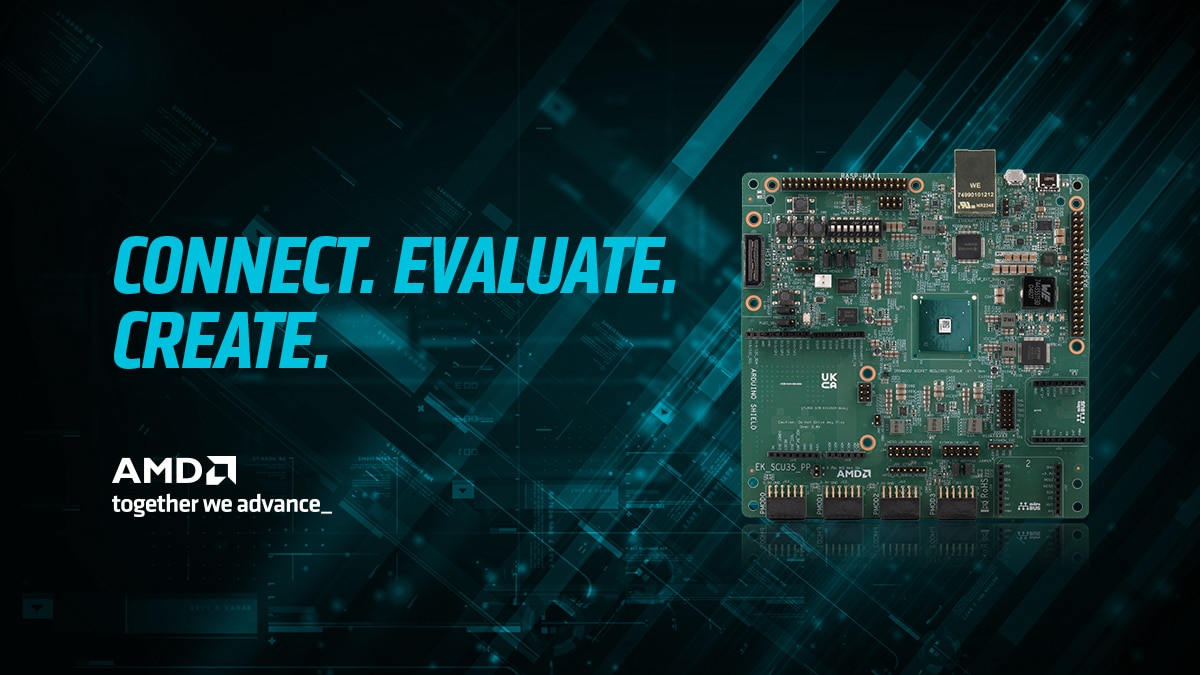New AMD Solarflare X4 Low-Latency Ethernet Adapter Set to Power Capital Markets
Oct 06, 2025

Leading Ultra-Low Latency Solution
For over 15 years, AMD Solarflare™ solutions have set the standard for ultra-low latency networking, empowering industries like capital markets to gain a true competitive edge. When complex trading algorithms shape global investments, every nanosecond matters—which is why speed and reliable execution are mission critical. Leading financial institutions trust AMD Solarflare for best-in-class performance, with 9 out of the top 10 global stock exchanges relying on these solutions to power their trading platforms and keep markets running smoothly.1
Tap into Exponential Gains
The AMD Solarflare™ X4 Ethernet Adapters represents a significant advancement in ultra-low latency Ethernet networking. As trading systems and high-performance applications continue to push the boundaries of speed and efficiency, the AMD Solarflare X4 Ethernet Adapters sets new benchmarks with industry-leading latency and throughput:
- Up to 40% lower latency than previous AMD Solarflare Ethernet Adapters generations2
- Enhanced Performance: 200% improved system performance and higher ingestion of market data compared to the AMD Solarflare X2 Series
- Backward compatibility for seamless integration with existing networking infrastructure
- Up to 12% lower latency compared to competition3 when leveraging AMD Solarflare X4 Ethernet Adapters with AMD EPYC™ 4005 Series CPUs 4
With these capabilities, the AMD Solarflare X4 Ethernet Adapters are designed to address the critical needs of industries where every nanosecond counts—offering the reliability, openness and consistency required to maintain a competitive edge in high-frequency trading, financial services, and other latency-sensitive environments.
Accelerate Services with AMD Onload™ Software
With AMD Solarflare™ solutions, capital markets firms can leverage AMD enterprise-class software and support within a single, unified vendor relationship. This streamlines workload acceleration, troubleshooting, and compliance activities—simplifying operations and supporting the legal and regulatory reporting requirements critical to financial environments.
AMD Solarflare Onload Software:
- Offers improved ultra-low latency
- Helps handle a high volume of small data packets quickly and reliably, even during peak trading activity.
- Reduces CPU workload by efficiently moving data, allowing more processing power for analyzing and executing complex trading strategies.
- Enables consistent, predictable response times and optimum performance on standard servers, avoiding common network slowdowns.
This makes the solution ideal for trading environments where speed and reliability are essential.
The World Trades on AMD Solarflare™ Ethernet Adapters
The AMD Solarflare X4 Ethernet Adapters deliver sub-microsecond latency with flexible form factors to meet diverse capital market needs. It combines industry-leading performance, forward-looking feature enhancements, and backward compatibility to drive faster, more reliable trading infrastructure.
Experience the definitive networking solution trusted by the world’s top financial institutions.
Begin powering your trading solutions with AMD Solarflare™ X4 Ethernet Adapters and AMD EYPC™ processors today.
Footnotes
- https://focus.world-exchanges.org/issue/june-2025/market-statistics Based on internal AMD analysis
- 9xx5-251: Solarflare Generational latency progression: AMD Internal Testing as of 9/15/2025. Workload config: Onload benchmarking tool measuring Latency for payload ranging from 0B to 648B in ns. System Config: 2 Supermicro systems consists of 1 AMD EPYC 9575F (64C, 12x 32GB DDR5-6400, Max speed of 5GHz), Ubuntu 25.04 with kernel 6.14-23, Custom BIOS version 5.35 (pre-release), OS configured with AMDLL profile and BIOS configured for low latency) with AMD Solarflare X4542 (bundle 1.0.3.2 and bootloader 1.0.17.0). AMD Solarflare X2522 (bundle 8.5.2.1000); AMD Alveo X3522 (bundle 1. 17.7.30). Release Candidate version of Onload is used (https://github.com/Xilinx-CNS/onload/commit/0395821bb0685a3019018b3a9b45c4f30915146f). Driver version 6.6.1.1005. AMD Low Latency Tuning guide available at https://www.amd.com/content/dam/amd/en/documents/epyc-technical-docs/white-papers/58649_amd-epyc-tg. Average 0 to 648B Latency comparison compared to X4: X3 is 1.27X (27.2%) higher and X2 is 1.43X (42.9%) higher latency. 4B latency comparison compared to X4: X3 is 1.35X (34.9%) higher and X2 is 1.55X (55.5%%) higher latency.
- Only for 4byte packets
- 9xx5-252: X4 latency across platforms: AMD Internal Testing as of 9/15/2025. Workload config: Onload benchmarking tool measuring Latency for payload ranging from 0B to 648B in ns. System Config: 2 Supermicro systems consists of one AMD EPYC 9575F (64C, 12x 32GB DDR5-6400, Max speed of 5GHz), Ubuntu 25.04 with kernel 6.14-23, Custom BIOS version 5.35 (pre-release), OS configured with AMDLL profile and BIOS configured for low latency) with AMD Solarflare X4542 (bundle 1.0.3.2 and bootloader 1.0.17.0). Release candidate version of onload (https://github.com/Xilinx-CNS/onload/commit/0395821bb0685a3019018b3a9b45c4f30915146f). Driver version 6.1.1.1005. AMD Solarflare X4542 (bundle 1.0.3.2 and bootloader 1.0.17.0) AMD Low Latency Tuning guide available at https://www.amd.com/content/dam/amd/en/documents/epyc-technical-docs/white-papers/58649_amd-epyc-tg… System config: 2 Supermicro systems consists of one AMD EPYC 4564P (AS -1015A-MT - 16C, up to 5GHz, 48GB memory). Driver version 6.1.1.1005, Custom BIOS version dated 8/30/24, kernel version 5.14.0-503. OS RHEL 9.4. AMD Solarflare X4542 (bundle 1.0.3.2 and bootloader 1.0.17.0) Driver version 6.1.1.1009 System config: 2 Dell R760 with one Intel Xeon 6534 (8 Core, 4.2GHz, 128GB, ), bios version 2.2.4, Ubuntu 25.04 with kernel 6.14.0-23, AMD Solarflare X4542 (bundle 1.0.3.2 and bootloader 1.0.17.0) driver version 6.1.1.1009, 2 NUMA nodes, 4B Payload size AMD Solarflare X4542 adapter installed on 2x 1P Intel Xeon 6534 based Supermicro system produced higher latency by 1.04X (4% higher) (23.7ns) compared to 2x 1P 9575F based Supermicro system AMD Solarflare X4542 adapter installed on 2x 1P EPYC 4564P based Supermicro system produced reduced latency by 0.91X (9% lower) (54ns) compared to 2x 1P 9575F based Supermicro system; AMD Solarflare X4542 adapter installed on 2x 1P EPYC 4564P based Supermicro system produced reduced latency by 1.1X (12.6%)(77ns) compared to 2x 1P 6534 based SuperMicro system.; 0 to 648B Payload size AMD Solarflare X4542 adapter installed on 2x 1P Intel Xeon 6534 based Supermicro system produced lower latency by 1.02X (13ns) (1.6%) compared to 2x 1P 9575F based Supermicro system AMD Solarflare X4542 adapter installed on 2x 1P EPYC 4564P based Supermicro system produced lower latency by 1.07X (52ns) (6.7%) compared to 2x 1P 9575F based Supermicro system; AMD Solarflare X4542 adapter installed on 2x 1P EPYC 4564P based Supermicro system produced reduced latency by 1.0X (4.8%)(199ns) compared to 2x 1P 6534 based SuperMicro system.
- https://focus.world-exchanges.org/issue/june-2025/market-statistics Based on internal AMD analysis
- 9xx5-251: Solarflare Generational latency progression: AMD Internal Testing as of 9/15/2025. Workload config: Onload benchmarking tool measuring Latency for payload ranging from 0B to 648B in ns. System Config: 2 Supermicro systems consists of 1 AMD EPYC 9575F (64C, 12x 32GB DDR5-6400, Max speed of 5GHz), Ubuntu 25.04 with kernel 6.14-23, Custom BIOS version 5.35 (pre-release), OS configured with AMDLL profile and BIOS configured for low latency) with AMD Solarflare X4542 (bundle 1.0.3.2 and bootloader 1.0.17.0). AMD Solarflare X2522 (bundle 8.5.2.1000); AMD Alveo X3522 (bundle 1. 17.7.30). Release Candidate version of Onload is used (https://github.com/Xilinx-CNS/onload/commit/0395821bb0685a3019018b3a9b45c4f30915146f). Driver version 6.6.1.1005. AMD Low Latency Tuning guide available at https://www.amd.com/content/dam/amd/en/documents/epyc-technical-docs/white-papers/58649_amd-epyc-tg. Average 0 to 648B Latency comparison compared to X4: X3 is 1.27X (27.2%) higher and X2 is 1.43X (42.9%) higher latency. 4B latency comparison compared to X4: X3 is 1.35X (34.9%) higher and X2 is 1.55X (55.5%%) higher latency.
- Only for 4byte packets
- 9xx5-252: X4 latency across platforms: AMD Internal Testing as of 9/15/2025. Workload config: Onload benchmarking tool measuring Latency for payload ranging from 0B to 648B in ns. System Config: 2 Supermicro systems consists of one AMD EPYC 9575F (64C, 12x 32GB DDR5-6400, Max speed of 5GHz), Ubuntu 25.04 with kernel 6.14-23, Custom BIOS version 5.35 (pre-release), OS configured with AMDLL profile and BIOS configured for low latency) with AMD Solarflare X4542 (bundle 1.0.3.2 and bootloader 1.0.17.0). Release candidate version of onload (https://github.com/Xilinx-CNS/onload/commit/0395821bb0685a3019018b3a9b45c4f30915146f). Driver version 6.1.1.1005. AMD Solarflare X4542 (bundle 1.0.3.2 and bootloader 1.0.17.0) AMD Low Latency Tuning guide available at https://www.amd.com/content/dam/amd/en/documents/epyc-technical-docs/white-papers/58649_amd-epyc-tg… System config: 2 Supermicro systems consists of one AMD EPYC 4564P (AS -1015A-MT - 16C, up to 5GHz, 48GB memory). Driver version 6.1.1.1005, Custom BIOS version dated 8/30/24, kernel version 5.14.0-503. OS RHEL 9.4. AMD Solarflare X4542 (bundle 1.0.3.2 and bootloader 1.0.17.0) Driver version 6.1.1.1009 System config: 2 Dell R760 with one Intel Xeon 6534 (8 Core, 4.2GHz, 128GB, ), bios version 2.2.4, Ubuntu 25.04 with kernel 6.14.0-23, AMD Solarflare X4542 (bundle 1.0.3.2 and bootloader 1.0.17.0) driver version 6.1.1.1009, 2 NUMA nodes, 4B Payload size AMD Solarflare X4542 adapter installed on 2x 1P Intel Xeon 6534 based Supermicro system produced higher latency by 1.04X (4% higher) (23.7ns) compared to 2x 1P 9575F based Supermicro system AMD Solarflare X4542 adapter installed on 2x 1P EPYC 4564P based Supermicro system produced reduced latency by 0.91X (9% lower) (54ns) compared to 2x 1P 9575F based Supermicro system; AMD Solarflare X4542 adapter installed on 2x 1P EPYC 4564P based Supermicro system produced reduced latency by 1.1X (12.6%)(77ns) compared to 2x 1P 6534 based SuperMicro system.; 0 to 648B Payload size AMD Solarflare X4542 adapter installed on 2x 1P Intel Xeon 6534 based Supermicro system produced lower latency by 1.02X (13ns) (1.6%) compared to 2x 1P 9575F based Supermicro system AMD Solarflare X4542 adapter installed on 2x 1P EPYC 4564P based Supermicro system produced lower latency by 1.07X (52ns) (6.7%) compared to 2x 1P 9575F based Supermicro system; AMD Solarflare X4542 adapter installed on 2x 1P EPYC 4564P based Supermicro system produced reduced latency by 1.0X (4.8%)(199ns) compared to 2x 1P 6534 based SuperMicro system.









